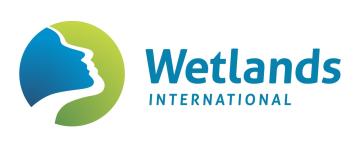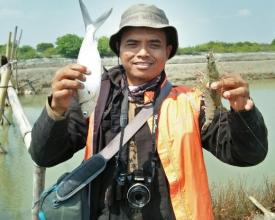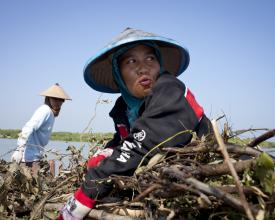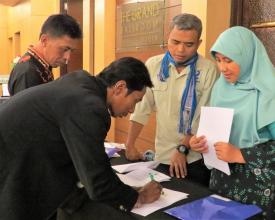
Acuicultura de manglares asociada

La expansión de la acuicultura del camarón ha provocado la pérdida de manglares en todo el mundo, haciendo que los deltas y las costas tropicales sean vulnerables a la erosión, las inundaciones y la pérdida de tierras, reduciendo así las opciones de subsistencia de las poblaciones costeras. En el distrito de Demak, en Java Central (Indonesia), introdujimos los sistemas de Acuicultura Asociada de Manglares (AMA). Se pidió a los agricultores que cedieran parte de su estanque de acuicultura construyendo un nuevo dique con nuevas compuertas y creando al mismo tiempo un espacio inclinado para un cinturón verde ribereño de manglares. Para crear voluntad y capacidad, los camaroneros locales recibieron formación sobre el terreno a través de escuelas de campo costeras que promovían prácticas de acuicultura respetuosas con el medio ambiente y podían aumentar sus ingresos. En el primer año, unos 100 criadores de Demak convirtieron el 10% de sus 104 hectáreas de estanques en hábitat de manglares, donde los sedimentos se asientan y los manglares crecen de forma natural en un año.
Contexto
Défis à relever
El primer reto, la voluntad de los agricultores de reducir el tamaño de los estanques, se superó gracias al aumento de los rendimientos y los ingresos tras la formación impartida en la escuela de campo. El segundo, el capital suficiente para construir el nuevo dique y las compuertas, se alivió con una subvención de Bio-Derechos (véase el bloque de construcción Bio-Derechos). Para el tercer reto, la ejecución técnica, preparamos directrices, impartimos formación a los trabajadores de campo y organizamos talleres prácticos para los agricultores participantes de cada comunidad. El cuarto reto se refiere a la eliminación del antiguo dique, ya que puede dar lugar a la pérdida de derechos sobre la tierra y a la exposición de los muros de contención de los estanques vecinos. Como primer paso, los agricultores abrieron las compuertas de los antiguos diques con mayor frecuencia o de forma permanente; cuando todos los estanques a lo largo de una vía fluvial se conviertan en Sistemas de Acuicultura de Manglares Asociados y la comunidad se haya pronunciado sobre los derechos de propiedad, los agricultores podrán dejar de mantener los antiguos diques o eliminarlos.
Ubicación
Procesar
Resumen del proceso
El CSA creó conocimientos y conciencia sobre la importancia de los manglares y reforzó la capacidad de los agricultores para aumentar de forma sostenible sus cosechas e ingresos. En general, esto les dio la voluntad de contribuir a la recuperación del cinturón verde, ya fuera renunciando a estanques enteros o construyendo AMA. Los contratos de bioderechos ofrecían a estos agricultores una compensación, bien por la pérdida de ingresos, bien por la inversión en el dique adicional con nuevas compuertas de agua. Esta última se organizó, como tradicionalmente, en grupos que se ayudaban mutuamente. [No entiendo esta frase. ¿Es necesaria?].
Así, se dotó a estos agricultores sin recursos de la capacidad humana, social y financiera para transformar su sistema de producción acuícola y contribuir a la recuperación de los cinturones verdes ribereños haciendo un AMA de sus estanques. Al beneficiarse de la mejora de las capturas, los pescadores apoyan la innovación a nivel comunitario, atribuyen presupuestos para la recuperación de los cinturones verdes y dictaminan los derechos de propiedad o de uso de los productos de los manglares.
Bloques de construcción
Escuelas de campo costeras
La mayoría de los acuicultores de Indonesia obtienen escasos rendimientos o beneficios debido a una formación insuficiente, malas prácticas y el uso de productos químicos y antibióticos que alteran el equilibrio ecológico. El CSA es un proceso de aprendizaje que refuerza la capacidad de los pequeños acuicultores locales y forma a pequeños grupos en buenas prácticas. Durante un ciclo de producción (12-16 sesiones), los agricultores aprenden ecología de estanques, gestión de estanques mediante acuicultura sostenible de bajos insumos externos (LEISA) y ecología de las aguas costeras, incluidas las funciones de los cinturones verdes de manglares (concienciación para la rehabilitación de los manglares). Los agricultores estudian el agroecosistema, diseñan sistemas de producción acuícola, observan estanques de demostración, sintetizan datos y debaten con sus colegas. Aprenden a fabricar compost líquido y seco para curar, abonar y gestionar el suelo y el agua de sus estanques. Por último, toman decisiones informadas sobre los siguientes pasos de la gestión de los estanques. A través de este proceso, los participantes pueden determinar las nuevas prácticas que les resultan prácticas para aplicarlas de inmediato. Los agricultores también adquieren más confianza a la hora de tomar decisiones y hablar en público. En este proyecto, una vez finalizado el plan de estudios, los alumnos siguieron participando en actividades posteriores a la escuela de campo (como sobre AMA y practicando formas de Acuicultura Multitrófica Integrada del Camarón (IMTA).
Factores facilitadores
- BwN Indonesia fue el primer proyecto en demostrar que la desastrosa erosión costera puede revertirse con estructuras permeables, lo que generó confianza.
- Los especialistas complementaron el plan de estudios, lo que incitó a los agricultores a seguir experimentando con nuevas técnicas y especies.
- Las pruebas previas y posteriores permitieron detectar y resolver los problemas a tiempo.
- Una reunión final para determinar las actividades de seguimiento dio lugar a la creación de plataformas independientes de agricultores que siguen experimentando y debatiendo lo aprendido.
Lección aprendida
- En Demak, más del 80% de los participantes adoptaron LEISA en cierta medida; y estos adoptantes triplicaron sus márgenes brutos en comparación con la mayoría de los no adoptantes. Esto significó que el coste de la formación se recuperó en un año, lo que convirtió a la CSA en una de las intervenciones de formación rural más eficientes. Además, el aumento de los ingresos alentó los esfuerzos por restaurar los manglares en aras de la seguridad costera.
- Algunos de los que no adoptaron LEISA se vincularon a otros proyectos que ofrecían plántulas gratuitas de camarones y peces de leche a condición de seguir las directrices del proyecto para la acuicultura.
- Reclutar a un 50% de mujeres fue todo un reto. En su último año, las formadoras del proyecto reclutaron participantes para dos CSA centrados en mujeres, incluyendo a mujeres entre los primeros adoptantes como cofacilitadoras.
- Después de una formación de CSA, los agricultores siguen innovando, por ejemplo, engordando cangrejo nadador azul y participando activamente en redes sociales (de aprendizaje). El CSA repercute tanto en los medios de subsistencia de la familia como en los de la comunidad.
Acuicultura de manglares asociada (AMA)
AMA conecta la acuicultura con los cinturones verdes de manglares a lo largo de las costas de los estuarios. Los cinturones verdes son inexistentes en la mayoría de las granjas. A diferencia de la mayoría de los sistemas de silvoacuicultura, donde los manglares se plantan en los diques y estanques, en AMA se sitúan fuera del estanque, donde los magroves contribuyen a mitigar el clima. Los manglares en los diques y estanques dificultan el mantenimiento de los estanques y su hojarasca y sombra reducen la productividad. Las hojas se descomponen en los estanques, proporcionando fuentes de alimento a los camarones y organismos de cultivo. Sin embargo, el exceso de hojarasca aumenta los niveles de amoníaco, disminuye el contenido de oxígeno disuelto y reduce la productividad de los estanques.
En AMA, la gestión del estanque no se ve obstaculizada por las hojas o la sombra, y se beneficia de una mejor calidad del agua entrante. Un solo agricultor puede practicar AMA, pero lo ideal es que todos los agricultores a lo largo de un canal mejoren el paisaje. Como los agricultores tienen que renunciar a una parte de su superficie de estanque, que representa un potencial de producción, se ven compensados con mejoras en el rendimiento. Los beneficios se obtienen del estanque más pequeño, aplicando las mejores prácticas de las Escuelas de Campo del Litoral.
Factores facilitadores
- El CSA mostró a los piscicultores cómo aumentar sus rendimientos utilizando LEISA y estanques más pequeños. Los agricultores de AMA consiguieron estabilizar sus ingresos a pesar de las inundaciones extremas.
- AMA proporciona a los agricultores ingresos adicionales gracias a los productos forestales y al aumento de las capturas en sus trampas de compuerta, así como mayores capturas de peces.
- En la isla de Tanakeke (Sulawesi meridional), los piscicultores que cedían la totalidad o una parte de sus estanques para la recuperación de los manglares podían inscribirse para obtener una exención fiscal (servidumbre de conservación).
Lección aprendida
- Los agricultores dudaban en retirar el antiguo dique que bordeaba el curso de agua, ya que limita su parcela. Dejar las viejas compuertas abiertas la mayor parte del tiempo fue suficiente para que se formara una nueva capa de sedimentos de 10 cm/año, y la afluencia de plántulas para el rebrote natural de los manglares.
- El mecanismo de financiación de Bio-Rights y la colaboración en grupo son medidas de acompañamiento esenciales para reclutar a los piscicultores pobres.
- Cuando el dique del estanque está muy protegido o soporta una gran carretera, su traslado requiere una planificación de distrito y una inversión importante.
- Los diques de estanque que llevan caminos aptos para carros pueden ser trasladados al unísono por los propietarios vecinos, aunque ello requiera planificación e incurra en costes. Los diques con senderos o caminos para bicicletas pueden trasladarse más fácilmente.
- Los diques de estanques compartidos con vecinos reacios a cambiar su sistema necesitarán un refuerzo estructural, ya que el nivel cambiante del agua puede causar erosión o una presión desigual.
- El estanque restante debe tener una anchura de 20 m o más. Los estanques más estrechos son costosos de transformar o resultan económicamente inviables. Aconsejamos la transformación completa al cinturón verde de manglares.
Recursos
Derechos biológicos
Muchos de los pobres de las zonas rurales se ven atrapados en una "trampa de pobreza para satisfacer las necesidades de subsistencia a corto plazo y se ven obligados a explotar de forma insostenible el entorno natural. La explotación conduce a una mayor vulnerabilidad y limita aún más sus oportunidades de desarrollo. Por eso, para conciliar la productividad de la acuicultura con la conservación y restauración de los manglares, introdujimos en Demak el mecanismo de incentivos financieros Bio-rights. A cambio de su participación activa en las medidas de conservación y restauración, las comunidades recibieron apoyo financiero y técnico para desarrollar medios de vida sostenibles. Los acuerdos de bioderechos son condicionales: los pagos a las comunidades sólo se completan tras el éxito de la restauración. El planteamiento cubre parte de los costes a los que se enfrentan los agricultores o la comunidad para cambiar sus actuales prácticas insostenibles (degradación del propio cinturón verde de manglares del que dependen para su seguridad costera) por estrategias de subsistencia sostenibles a largo plazo. Esto les motiva a interesarse también a largo plazo por su labor de conservación. Algunos grupos comunitarios reservan una parte del capital en un fondo de ahorro colectivo.
Factores facilitadores
- Los grupos comunitarios de 9 pueblos de la costa de Demak contaron con el apoyo del personal indonesio del consorcio Building with Nature, que residió en el distrito de Demak durante todo el plazo del proyecto.
- Las comunidades locales designaron a las personas que participarían en los programas.
- Todos los grupos comunitarios deben estar bien organizados y ser capaces de acceder, recibir y gestionar fondos públicos.
- El enfoque de los bioderechos se basa en la capacidad y la concienciación de los miembros de la comunidad; ambas se fomentaron a través de las escuelas de campo costeras.
Lección aprendida
- Antes, tras la conversión de los manglares en estanques, los agricultores no reflexionaban sobre los vínculos entre sus medios de vida y los manglares. Aceptaban pasivamente las inundaciones y la disminución de los rendimientos de la acuicultura y la pesca.
- Después de que la CSA hubiera despertado la concienciación, la creatividad y la voluntad, el enfoque de los bioderechos fue el último empujón para que las comunidades dedicaran zonas a la restauración de los cinturones verdes.
- Los fondos se pusieron a disposición de los grupos comunitarios a cambio de la prestación de "servicios ecosistémicos" para impulsar los medios de subsistencia.
- Para garantizar una financiación sostenible de la rehabilitación de los manglares, una parte de los fondos puede reservarse a un fondo de ahorro colectivo y/o utilizarse para actividades económicas rentables. En Demak, un pueblo inició un paseo comercial por los manglares; otros compraron máquinas para preparar el abono (líquido) para sus estanques.
- Al incluir la política y la promoción en los paquetes, las comunidades consiguieron arraigar las medidas en los planes de desarrollo de las aldeas. Como resultado, las comunidades ya reciben fondos ad hoc o anuales del gobierno del pueblo y del distrito para diversas medidas.
Impactos
La Acuicultura de Manglares Asociada (AMA) crea un hábitat en el que los manglares pueden reclutarse de forma natural, restaurando así los cinturones verdes de manglares a lo largo de las vías fluviales del estuario. Estos cinturones verdes ribereños contribuyeron a la conservación de la biodiversidad, la sedimentación y, por tanto, la protección de los estanques colindantes, y mejoran la calidad del agua. El paisaje de manglares restaurado, con una buena conectividad entre los hábitats costeros y fluviales, mejoró la pesca de captura. La AMA es un tipo de silvo-acuicultura, pero a diferencia de los sistemas habituales promovidos en Indonesia, donde los manglares se plantan en los diques y en el estanque, los manglares de la AMA se sitúan fuera del estanque y, por tanto, tienen más funciones ecosistémicas.Además, separar los manglares del estanque permite gestionar mejor la calidad del agua para las especies cultivadas, y los estanques más pequeños suelen proporcionar mayores rendimientos. Gracias a las buenas prácticas de acuicultura, la productividad del estanque restante y los ingresos de los agricultores aumentaron (véase Building Block Coastal Field Schools). El litoral protegido por los manglares y el aumento de los ingresos ayudaron a las comunidades a adaptarse y mitigar los efectos del cambio climático.
Beneficiarios
Piscicultores a lo largo de la costa (rendimientos estables), más lejos (estanques protegidos)
Pescadores (mejora de las poblaciones de peces)
Toda la comunidad: reducción de riesgos (inundaciones, erosión), biodiversidad.
Autoridades locales : reducción de riesgos, impulso de la economía local.
Objetivos de Desarrollo Sostenible
Historia

AMA y el IMTA cambiaron los medios de subsistencia de la familia
Desde el año 2000, pak Abdul Kohar no criaba gambas ni peces de leche en su estanque de 2 hectáreas. Al segundo mes de haber sembrado gambas, la mayoría murieron y otras se perdieron durante las mareas vivas. Así que recogía el marisco salvaje que quedaba atrapado en su estanque y en las trampas de la compuerta en luna llena. En 2017, el proyecto Building with Nature Indonesia propuso al grupo del pueblo aplicar AMA en estanques adyacentes a ríos. La ubicación de su estanque cumplía los criterios, y construyó el dique y las compuertas adicionales con dinero del mecanismo de bioderechos. En 2018, empezó a vaciar diariamente las trampas de sus compuertas. Los resultados le hicieron muy feliz, junto a peces, como salmonetes y pargos blancos, capturó langostinos tigre (Penaeus monodon) y camarones blancos (P. merguensis); los dos últimos apenas los había capturado en los últimos años. Esto hizo pensar a Kohar que su estanque podría volver a utilizarse para el cultivo.
Además, en 2017, UNDIP-FPIK-Aquaculture buscó agricultores que pusieran a prueba el IMTA. En este IMTA se combinan camarones, peces de leche, algas, berberechos y una jaula con tilapias para aprovechar todos los nutrientes del agua. Pak Kohar probó a cultivar juntos el langostino tigre, el pez leche, las almejas de sangre y las algas. En el primer ciclo, los langostinos no murieron; en el tercer mes, cosechó 50 kg de langostinos tigre y 500 kg de almejas de sangre, de los que inicialmente almacenó 200 kg. Además, la cosecha de langostinos, que antes de 2000 era de sólo 200 kg, alcanzó los 600 kg.
Pak Kohar también consiguió cultivar algas y producir un volumen suficiente para interesar a los compradores de las fábricas. Más tarde, propuso a varios otros agricultores que añadieran algas en su estanque camaronero. Este éxito inicial animó a Kohar a gestionar su estanque con más seriedad. Tras preparar el estanque, añadió tilapia a sus otros cultivos. Su segundo año fue aún más exitoso: Sus rendimientos se duplicaron en el caso de los camarones y el pez lechoso, y se triplicaron en el de las almejas. Además, las capturas diarias en sus trampas aumentaron tanto en volumen como en variación. También capturó cangrejos nadadores azules, que tienen un alto precio de venta.
Este éxito general dio a Kohar el capital necesario para mejorar su otro estanque. Kohar también aplica AMA, IMTA y sus otros aprendizajes del AFS. Con el dinero restante, compró una moto nueva para el transporte diario de su pequeña familia.





















